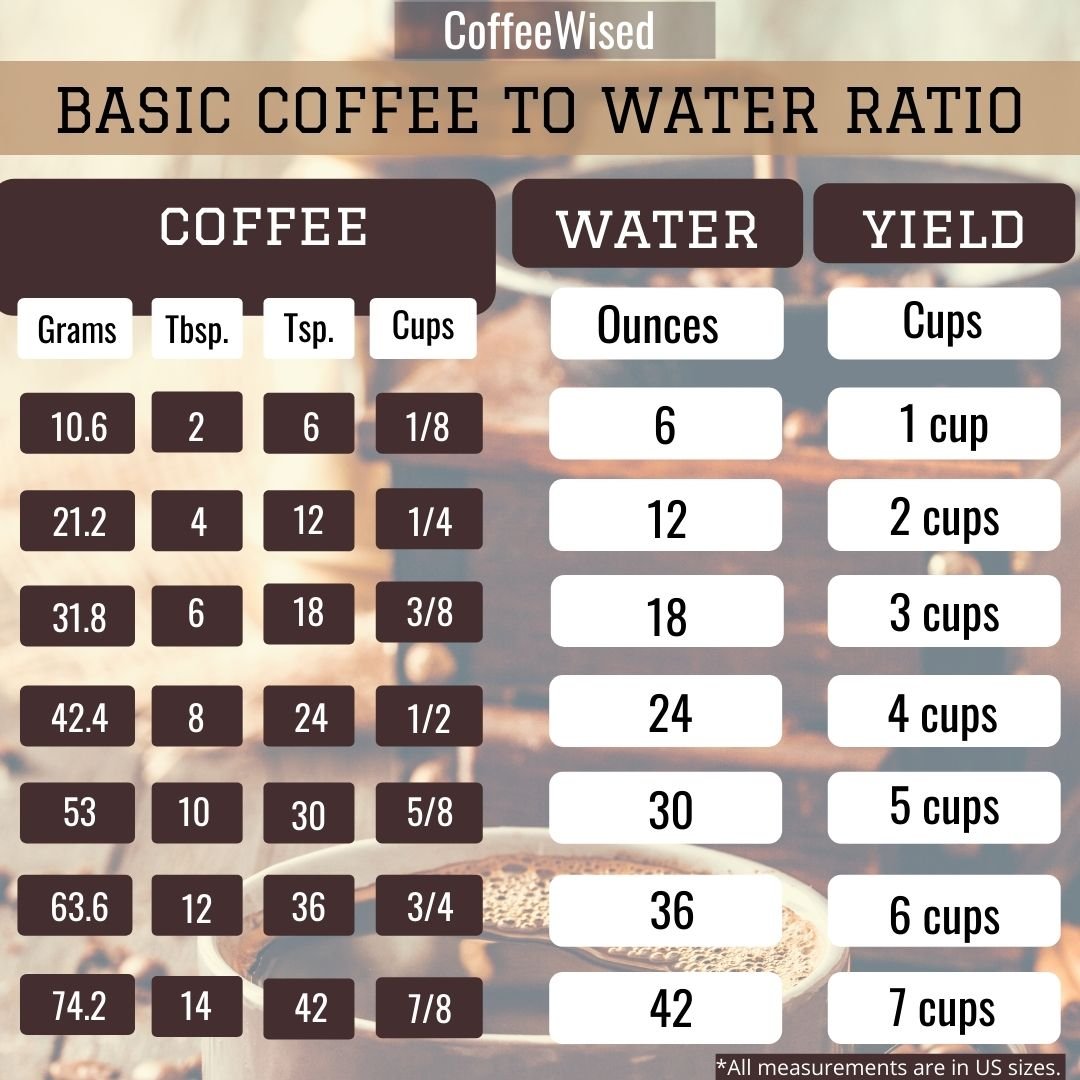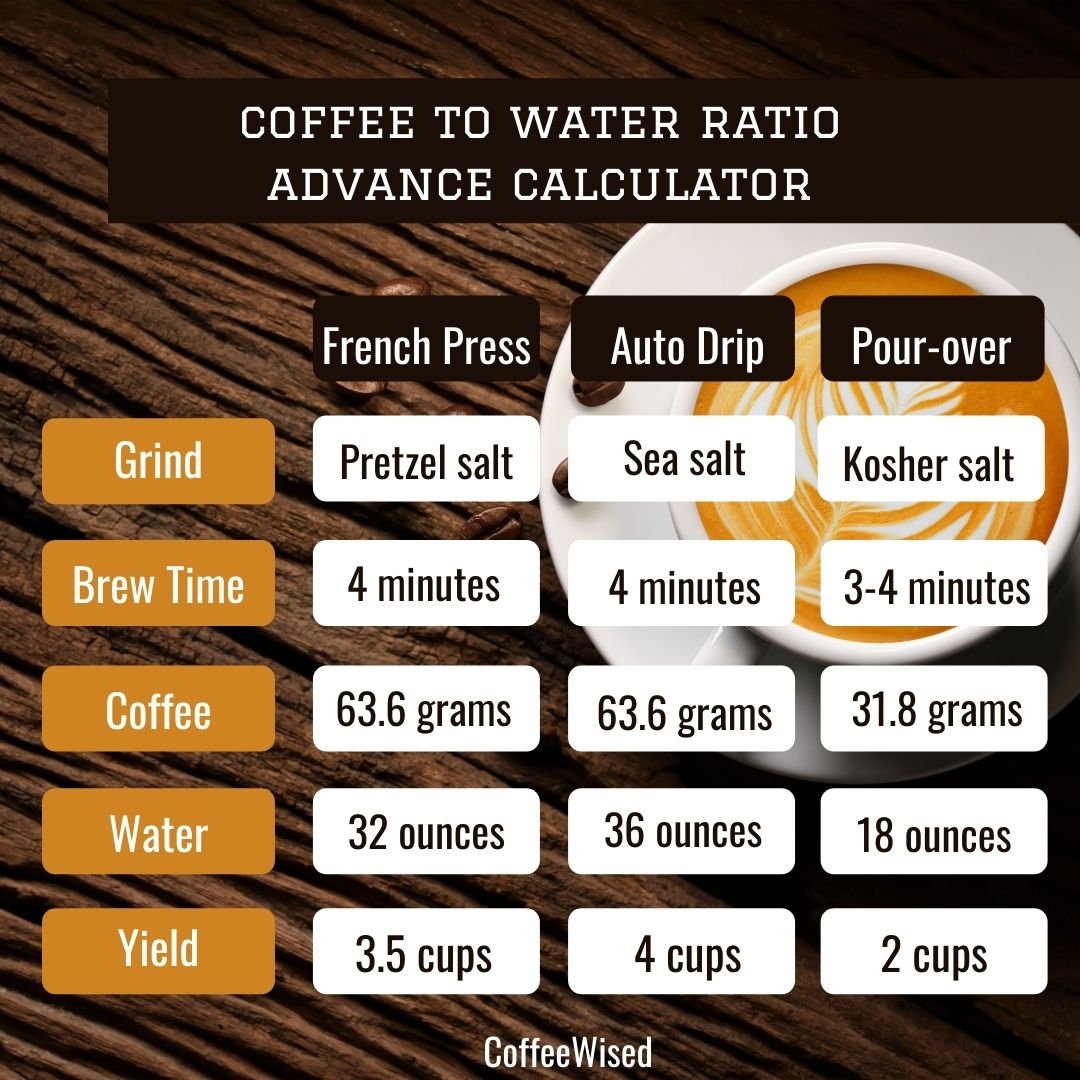Coffee to Water Ratio: What Makes a Perfect Cup?
The wrong coffee to water ratio can ruin your whole day.
I have missed work deadlines on bad coffee days, that’s why I know the pain. Even a difference of 5 grams in coffee to water ratio can swap your perfect cup of coffee into watery or too strong.
The Four Smooth Sailors
Who does not want a perfect cup of coffee every day?
4 Basics that Make Your Coffee a Hit or a Miss
Keep these 4 basics right to start your day bright! Without further ado, let’s get straight to the numbers.
1. Proportion or Ratio
For six ounces or 180 ml water, you need two tablespoons or 10 grams of ground coffee. You can experiment up to 11.6 grams of coffee to 180 ml water, but if you go above 11.6 grams, the end result could be under-extracted coffee. If you take less than 10 grams, you may have over-extracted coffee.
2. Water
Water makes up 98% content of coffee, so we cannot ignore it at all. The water you use should be clean and free from impurities. Bottled spring water is the best choice for any type of coffee. The temperature of the water when it meets coffee grounds is also important. You need water temperature just below boiling temperature.
- If you have a thermometer, marry water and coffee grounds at 90–96-degree C.
- If you do not have a thermometer, then bring water to boil, turn off the flame, and keep it covered for 30 seconds. Then mix with coffee to get maximum flavor extracted from coffee.
3. Grind
Some brewing equipment makes better coffee with the fine ground, while others make the perfect cup of coffee with the coarse ground. A traditional coffee press, like French Press, will help extract the finest and richest coffee with the coarse ground. Make sure that you always choose the right type of grind for the equipment you are using. The coffee grind size chart has all the details you need to know about correct grind types and equipment.
4. Freshness
Roasted coffee easily reacts to moisture and oxygen in the air. Popular coffee chains use freshly roasted coffee every day. Now, we cannot grind and roast our coffee at home every day, so the answer is to buy freshly roasted coffee and store it properly. Roasted coffee should not last longer than a week even when stored perfectly.
How do you store freshly roasted coffee?
Put your roasted coffee in a clean glass jar with an airtight lid. Make sure that you store it in a cool place (not in the refrigerator), ideally on a closed shelf that is not close to the stove or heating equipment. Close the lid as soon as you take out the coffee. If you have coffee left in the jar after a week, you can use it as a fertilizer in the garden.
It’s also important to buy roasted coffee from a trusted supplier. Look for local coffee roasters and make sure that they clean their roasting equipment between batches to avoid moisture and oxygen reaction with ground coffee.
Coffee to Water Ratio Calculator

Digital coffee to water ratio calculator is a good technique for beginners to find their starting point. However, these calculators do not give you accurate measurements, because:
- Your sweet spot of caffeine depends on your palate.
- Fine coffee grounds to water ratio is different from that of coarse ground.
- The brewing technique can extract more caffeine and oils, if done wrong.
Standard drip coffee maker is more popular at homes. This is why the coffee to water ratio calculator that you see online is mostly designed for drip coffee makers.
How Do Baristas Measure Best Coffee to Water Ratio?
Baristas keep an eye on several factors including using the best coffee to water ratio for different types of coffees. The most important ones are the size of the coffee grounds and the brewing method.
A general rule of thumb is that for a very fine ground of coffee, take a little less coffee than you would take for coarse ground, considering the same brew time.
Professional baristas rely on 1:4 measurement, that is one tablespoon of coffee for every 4 ounces of water. They also strongly trust their gut. If they feel the cup of coffee is not strong enough or the first sip may miss the caffeine hit, they sprinkle a little coffee on top of the frothed milk.
Baristas prefer full immersion brewing techniques, like clever drippers, siphons, and French Press.
How Many Scoops of Coffee Do I Need for 1 Cup?
The ideal method to measure the best coffee to water ratio is by grams. However, if you are using a scoop to measure your coffee, then here is a quick tip.
A scoop carries around 2 tablespoons of coffee.
- If you want to make a very strong cup with coarse ground coffee, then use 1 scoop for 1 cup of coffee.
- If you want light caffeine punch, then use half a scoop for 1 cup of coffee.
- If you are using finely ground coffee, then use 2/3rd packed scoop for 1 cup of coffee.
The Tablespoon Confusion
The little scientist in me dies every time my tablespoon gives a different measurement in grams.
I know I am not alone in this boat.
So, I tried to find a solution and succeeded. Here we go.
1 leveled tablespoon is equal to 5 grams.
1 heaped tablespoon is equal to 5.3 grams.
When we say two tablespoons, it actually means 10.6 grams.
Coffee to Water Ratio for Different Types
Measurements of coffee go wrong when you are not good at converting units like me. So, what do you do? I used to search unit conversions on Google until I created my unit conversion chart and put it up here for your lifetime convenience. You can download this and paste it right above your coffee station. This is my second-best investment after Keurig K-Elite.
Here I have explained the best coffee to water ratio for different brewing methods. The measurements are in grams.
If you use another unit, use the chart to convert from grams of coffee to your desired unit.

Coffee to Water Ratio Espresso
The most commonly used coffee to water ratio espresso in cafes is 1:2. This means that if you are using 6 grams of coffee beans, then take 1 ounce of water to make espresso.
Starbucks Coffee to Water Ratio
Ideal Starbucks coffee to water ratio is 10 grams of coffee for every 180 ml of fresh water. Starbucks uses freshly roasted coffee, which gives Starbucks coffee a hit over others.
Coffee to Water Ratio Drip
For drip coffee, we use the Golden Ratio, which is 1 gram of coffee for each 15-18 grams of water. Some people define it as one to two tablespoons of coffee for 6 ounces of water. The range in measurement can be adjusted as per personal preference for coffee to water ratio drip.
Instant Coffee to Water Ratio
Instant coffee is finely ground, which is why we need to be very careful when making an instant cup of coffee. Take around 8 ounces or 1 cup of water that is just under boiling temperature. Add 1 heaped teaspoon of instant coffee to water. This instant coffee to water ratio will give you a perfect cup of espresso.
If you are making instant milk coffee, then add a quarter or half a teaspoon more instant coffee. Doing this will help you adjust the flavor of coffee against milk or another dairy.
Coffee to Water Ratio Cold Brew
Cold-brewed coffees are the tastiest, but a little tricky too. Make cold brew coffee with 1 part coarsely ground coffee to 8 parts water and leave it to chill for 24 hours.
Sometimes, it’s good to experiment with coffee to water ratio cold brew. You can experiment with 1 part coffee to 4 parts of water, or even 1 part coffee to 2 parts of water for a stronger caffeine kick.
Coffee to Water Ratio for Pour Over
For 1 cup of pour-over coffee, you need around 2 scoops or 29 grams of coffee. You can also measure it as 2 grams of coffee per ounce of water. Pour-over coffee to water ratio also depends on the brew time. Around 3-4 minutes of brew time with a perfect coffee to water ratio for pour-over will serve you with the right amount of caffeine richness.
French Press Coffee to Water Ratio
French Press is my personal favorite to brew the richest and tastiest coffee. The ideal coffee to water ratio French Press is 1 gram coffee for every 13-15 grams of water. This means you need around 3 tablespoons of coffee per cup when brewing with French Press.
Coffee to Water Ratio AeroPress
AeroPress is known for more concentrated brews. The ideal coffee to water ratio AeroPress is 2.5-2.6 grams of coffee per ounce of water. After pouring water in the AeroPress and stirring the coffee, let it steep for 30-60 seconds, depending on how strong the coffee you want.
What is the Ratio of Coffee to Water in Cups?
Almost all brewers have indicators to fill water. If you do not have one, then measure six ounces of water to make one cup of coffee. Add one to two tablespoons or 10.6 grams of coffee.
How much coffee do I use for 8 cups?
For making 8 cups of coffee, you need around 14 tablespoons or 80 grams of ground coffee. It is a good starting point, but you can go up to 16 tablespoons for extra caffeine.
What is a 1/16 ratio for coffee?
1/16 ratio for coffee is also known as the Golden Rule. It means that for every 16 grams of water, you need 1 gram of coffee. However, this ratio is different for different brewing methods. Some brewing techniques require a 1:13 coffee to water ratio, while others may need a 1:17 measurement or more.
Adjusting the Measurements
Your caffeine and flavor preferences could be different from your friend. Even if you measure the ratios by grams, you may still need to adjust the measurements. 1:17 measurement is a good starting point. Then you can increase or decrease the measurements to find the right balance.
When experimenting with the measurements, it is best to keep one component constant. For me, it is water. This way, you will get better control over the flavor and richness of your cup. You can predict the results more precisely this way, and reach your ideal balance quickly.
I would not recommend going above the ideal 1:18 measurement. If using 1:18 measurement is not giving you the right flavor, then it is time to move up to a darker roast. You can also try using another type of equipment that works with a fine grind.
Sincere Advice Here!
Different methods need different measurements. Listen to your gut, experiment a lot, and write the ratios you use every time until you find the perfect ratio that suits your palate. Truly, in the end, it’s always you who can define your perfect coffee to water ratio.
